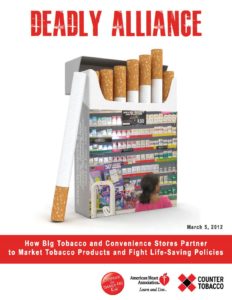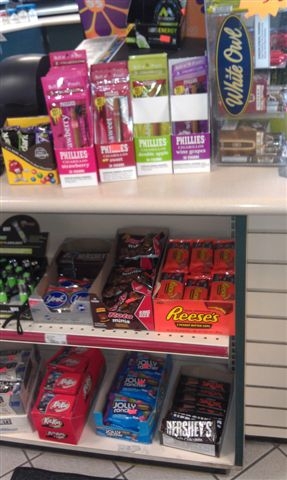Welcome to CounterTobacco.org’s “News and Research Roundup!” Each month we post a summary of the latest research, reports, and news stories on counteracting tobacco product sales and marketing at the point of sale (POS). Keeping up with what’s happening in the POS movement all across the country can help you choose policies and strategies that work best for your community. New research can help provide support for your work and evidence for the importance of the “War in the Store.” Have a story you don’t want us to miss? E-mail it to us!
New Research
- Characteristics of tobacco purchases in urban corner stores, Tobacco Control
- Data collected on purchases from corner stores in the city of Philadelphia, Pennsylvania from April to September 2012 showed that only 13% of purchases included tobacco products, of which 61% did not include any other products. Of all tobacco product purchases, 24% were for lower-cost products, such as cigars and cigarillos. No difference was found in the average amount that consumers spent on food or beverages when purchased with or without tobacco products. Researchers suggest that these findings challenge the idea that tobacco sales are associated with sales of other products in corner stores and may help to assuage concerns about reduced foot traffic when retailers voluntarily give up tobacco sales or as a result of future point of sale policies that restrict tobacco sales.
- Tobacco companies’ use of retailer incentives after a ban on point-of-sale tobacco displays in Scotland, Tobacco Control
 Qualitative interviews were conducted with 24 small retailers in four Scottish communities following Scotland’s prohibition on the open display of tobacco products in stores. Researchers found that tobacco companies continued to incentivize retailers to sell and promote their brands, providing incentives for maintaining stock levels, positioning brands in specified spaces in the storage units, increasing sales, trialing new products, and participating in other specific promotions. While tobacco companies have incentivized retailers in similar ways in the past, this study shows that they have adapted their strategies to continue to do so within the context of a display ban.
Qualitative interviews were conducted with 24 small retailers in four Scottish communities following Scotland’s prohibition on the open display of tobacco products in stores. Researchers found that tobacco companies continued to incentivize retailers to sell and promote their brands, providing incentives for maintaining stock levels, positioning brands in specified spaces in the storage units, increasing sales, trialing new products, and participating in other specific promotions. While tobacco companies have incentivized retailers in similar ways in the past, this study shows that they have adapted their strategies to continue to do so within the context of a display ban.- Learn more about how Big Tobacco incentivizes U.S. convenience stores in the Deadly Alliance report.
- Listen to a podcast with one of the study’s authors here.
- News Story: Industry steps up efforts to minimize impact of open display tobacco ban, Medical Xpress
- Responsiveness to cigarette prices by different racial/ethnic groups of US adults, Tobacco Control
- This study found significant price elasticity for smoking for whites, African-Americans, Asians, and Hispanics and significant price elasticity for smoking intensity for whites and African-Americans. However, elasticity varied across groups, indicating that raising cigarette prices would reduce cigarette consumption in all groups, but to different degrees, with greater magnitude of effect on whites and Asians compared to African-Americans and Hispanics. For every 1% increase in price, demand for cigarettes decreased by 0.48% for whites, 0.27% for African Americans, 0.22% for Asians, and 0.15% for Hispanics.
- Learn more about different types of non-tax policies that increase the price of tobacco products, which can have pro-equity effects.
- Tobacco industry response to a ban on lights descriptors on cigarette packaging and population outcomes, Tobacco Control
- When the 2009 Family Smoking Prevention and Tobacco Control Act banned the use of “light,” “mild,” or other similar descriptors for labeling cigarettes, tobacco companies replaced those descriptors with color-coded packages. This study shows that the market share of cigarettes with the filter ventilation design of those previously labeled “light” did not change after the ban, nor did rates of use and initiation among youth using these cigarettes. The authors suggest that tobacco companies circumvented the intent of the tobacco control act by using color-coded sub-brands to make implicit, inaccurate reduced-risk claims, and that requiring plain packaging and eliminating sub-brand descriptors could more effectively prevent the companies from misleading consumers.
- Learn more about “The Light and Low Deception“
- Basic science and public policy: Informed regulation for nicotine and tobacco products, Nicotine & Tobacco Research
- The authors recommend increased open, bidirectional communication between scientists and policy makers to further develop informed and effective policies and programs that reduce the appeal, addictiveness, and harmful health effects of tobacco products.

Cigarillos near candy
- The authors recommend increased open, bidirectional communication between scientists and policy makers to further develop informed and effective policies and programs that reduce the appeal, addictiveness, and harmful health effects of tobacco products.
- Changes in the availability and promotion of non-cigarette tobacco products near high schools in New Jersey, USA, Tobacco Control
- Researchers surveyed all tobacco retailers within a half-mile radius of 41 high schools in New Jersey in April 2015 and again in April 2016. They found that cigars/cigarillos were the only products that became more available and the only product for which stores had increased exterior and interior advertising. Cigars/cigarillos were available in 91.2% of stores near low-income schools compared to 82.6% of stores near mid-to-high income schools. While e-cigarette availability declined over the course of the year, e-cigarettes were promoted more and were more accessible in mid-to-high income districts and near schools with a majority white population. Smokeless tobacco promotion remained stable over the year, but was more common near mid-to-high income schools and schools with majority white populations. Tobacco retailer density was also higher near lower income schools compared to mid-to-high income schools.
- Learn more about non-cigarette tobacco products.
Industry News
- Shareholders back British American Tobacco buying Reynolds, Associated Press
- BAT to submit FDA application to sell Glo in U.S., MarketWatch
- Judge decides in favor of FDA in legal battle against Nicopure Labs, Vaping Post
- Reduced-Risk Products Front of Mind for C-store Retailers, Convenience Store News
- iQOS Ad Strategy Revealed, CSP Daily News
- Tobacco companies diversify into ‘pharmaceuticals’, Reuters
- Smokers Feel Heat but Not the Burn – WSJ, Fox Business
POS Policy in the Media
 Menthol and Flavored Tobacco
Menthol and Flavored Tobacco
- Minneapolis City Council Approves Menthol Tobacco Restriction, Star Tribune
- Fate of San Francisco’s Ban on Flavored Tobacco Products Is Now Up To Voters, California Healthline
- Oakland bans sale of menthol cigarettes, flavored blunt wraps, East Bay Times
- Sacramento Communities Eye Yolo County’s Flavored Tobacco Ban, Capital Public Radio
- Lobbyists descend on Minneapolis to fight menthol restriction, Star Tribune
- Opinion: Bay Area puts up a fight against Big Tobacco, Easy Bay Times
FDA and National News
- FDA aims to lower nicotine in cigarettes to get smokers to quit, Washington Post
- F. D.A. Delays Rules That Would Have Limited E-Cigarettes on Market, New York Times
- FDA to launch campaign against e-cigarette use among youth, Reuters
- Premium cigar industry gets 3.5 more years to argue against stricter FDA regulations, Tampa Bay Times
- We have an opioid overdose crisis, but cigarettes still kill 15 times more people, Vox
- Big Tobacco Won’t Let FDA Cut Nicotine Without a Fight, Bloomberg
- Warnings on US cigarette packs not as effective as those in other countries, The Conversation
- Big Tobacco’s new cigarette is sleek, smokeless, but is it any better for you?, Washington Post
Tobacco 21
- Maine Raises Smoking Age to 21 After Lawmakers Override Veto, New York Times
- New Jersey raises age for tobacco sales to 21, joining California and Hawaii, Washington Times
- Brown signs Oregon law increasing tobacco age to 21, KATU
- Douglas becomes second AZ city to raise legal tobacco age to 21, Tucson News Now
- Louis Park to raise tobacco age, KARE 11
- Port North raises tobacco age to 21, The Island Now
- Shawnee County Commission Votes to Raise Age to Buy Tobacco, KMUW
 Other
Other
- City Council votes to raise cost of cigarettes to $13 a pack, ban pharmacy sales, Crain’s New York Business
- Protecting Milwaukee Youth from Predatory Tobacco Marketing, Shepherd Express
- CNY Youth Make the Case for a Tobacco-Free Generation, WAER
- New study shows cigarette sales in California dropped dramatically since new cigarette tax went into effect, ABC 30
- Volusia County pushes to keep teens from e-cigarettes, My News 13
Find more stories in last month’s News and Research Roundup.
Know of a story that we missed? Email us, and we’ll be sure to include it in next month’s roundup!


